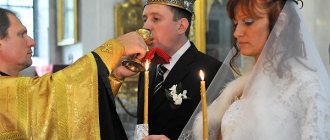Website of the Gorlovka and Slavic diocese
About the meaning, symbolism and traditions of one of the most beautiful sacraments of the Church.
Is it possible to get married if your parents are against it? Do pregnant and already married people get married? Is it permissible to take someone else’s rings or dress for the sacrament? Should the bride hide her face from the groom? Will a wedding ensure a strong marriage and a comfortable life?
The spiritual essence of a wedding
Jesus in the Bible said that people cannot destroy a union blessed by God. (Matthew 19:4-8).
The wedding ceremony in the Orthodox Church is an action performed by priests as intermediaries between God and people, during which two souls merge into one.
Genesis 1:27 says that God created man, notice, not two people, but one - the Lord created male and female.
The sacrament of a couple coming down the aisle consists of calling on the help of the Holy Trinity to give a blessing for their future family life.
During the blessing ceremony, the couple comes under the spiritual protection of the Church, becoming a part of It.
The head of the family is the husband, and to him is Jesus.
The married couple is a prototype of the relationship between Jesus and the Church, where Christ is the groom, and the Church is the bride, awaiting the arrival of His betrothed.
In a small church-family, services also take place in the form of general prayers and reading the Word of God, and the spouses make their own sacrifices for obedience, patience, submission and other Christian sacrifices.
About family life in Orthodoxy:
- What is an Orthodox family
- Responsibilities and Instructions for Husband and Wife
- Married life during Lent
Children born to an Orthodox couple are given a special blessing at birth.
Starting a common life, even if Christians are not true doers of the Word of God and rarely attend temple services, they can come to God through the Sacrament of uniting two into one.
Only by standing under the crown of God's blessing can one feel the power of His grace.
Sometimes a couple is in love with each other only on a physical level, but this is not enough to build a happy life together.
After the rite of spiritual union, a special connection appears, giving a strong impetus for a long-lasting marriage.
Receiving blessings in the temple, the couple trusts themselves to the protection of the Church, letting Jesus Christ into their life as the Lord of the house.
After the perfect ceremony, God takes marriage into His hands and carries it through life, but subject to the observance of Christian laws by family members and chastity.
Wedding
Wedding ceremony from a cultural point of view
The Slavic chronicles conveyed to us in detail the life of the Russian people, their habits, beliefs, focusing on significant milestones in life. Birth, wedding, and death were outlined by religious ideas, which changed over time, but their essence remained unchanged.
A wedding is a purely church ritual. It will be effective if the couple unites each other into a whole (two halves - one whole). In society, such a couple begins to be very lucky (luck, health, etc.).
Weddings among the Slavs were endowed with a magical meaning - to protect the newlyweds from damage, the evil eye and evil spirits. The wedding took a long time to prepare, clothes were specially sewn for it, hats, rings, protective dishes were chosen - all actions were aimed at ensuring that the young people lived in abundance and had healthy children.
With the introduction of Christianity in Rus', weddings did not cease to be a sacrament; on the contrary, it was believed that couples married by God would be happy and bear many offspring. A wedding has become a milestone when two people take care not only of each other, but also participate in the birth and upbringing of children, according to Christian canons. The dissolution of a marriage concluded in the church was unacceptable and was regarded as a sin.
What is the spiritual process of preparing for a wedding?
The wedding rules in the Orthodox Church state that one should prepare for an important event in spiritual life. Govenye is a Christian feat of the future family before the Holy Church.
Without confession and communion of the Holy Mysteries, a couple cannot be admitted to the ceremony of blessing before God.
Following all the recommendations for preparing for confession, both the bride and groom should pray intensely and ask God:
- show all sins, explicit and implicit, and forgive them;
- let go of all those who offend from your heart;
- ask forgiveness from those offended;
- pay off debts.
After confession, the couple is allowed to receive communion.
How can you get debunked?
- The dissolution of a God-blessed Marriage is a great sin, therefore there is no such thing as “debunking”. It is impossible to bless sin; the Savior Himself commanded: what God has joined together, let not man separate (Matt. 19:6). In Orthodoxy there are no destructive rites at all: baptism, debunking, defrocking. What is given liturgically is terminated by the decision of the bishop.
- If the first marriage actually broke up, then the innocent party may be given a blessing for the second marriage, and, as a last resort, for the third, but no more. A blessing can only be given by the diocesan bishop, but not by the priest.
What to buy before the wedding
There is a whole list of items needed to perform the ritual.
- Wedding icons are an important attribute when blessing a couple. In the future, the Holy images of the Mother of God and Jesus Christ will become a talisman and blessing shrines for the family.
- Wedding rings have no edge or end. By putting the ring on each other, the bride and groom swear eternal love and the indissolubility of their consecrated marriage.
Gold rings are symbols of the sun's radiance, silver rings are a reflection of the moonlight, which shines in the reflection of the sun.
So the Orthodox family shines in the reflection of the love of God's Trinity.
- Candles for weddings.
- Handkerchiefs to hold candles and crowns.
- Embroidered towels or boards that: decorate icons;
- cover a tray with a loaf of bread;
- placed under your feet.
Wedding icon
Why is it necessary for a family: the opinion of the church
The church contrasts marriage according to the Orthodox tradition with the unspiritual life of a consumer society. Family in the life of a believer is a stronghold that grants:
- mutual support in everyday difficulties;
- joint spiritual development;
- nurturing each other;
- the joy of mutual love blessed by God.
A married spouse is a companion for life. The spiritual strength received in the family is then transferred by a person to social and government activities.
Is the presence of witnesses mandatory?
Before the revolution, marriage took place only in the temple and had all civil and legal rights.
Orthodox weddings took place only in the presence of guarantors, current witnesses who were recorded in church books as recipients.
As a rule, people who knew the families of the bride and groom were taken as witnesses. The guarantors not only confirmed the completed Sacrament with their signatures, but later became trustees of the young couple.
At that time, unmarried, young people who themselves did not yet know the complexities of family life were not taken as witnesses. When church records disappeared, these people acted as witnesses to the completed Sacrament.
Nowadays, the church does not require the obligatory presence of witnesses at marriages, but welcomes when relatives, friends and relatives come to share the Sacrament with the newlyweds.
Witnesses, Orthodox Christians, hold crowns over the heads of the couple.
The bride or witness must take care of snow-white festive scarves in advance for this action.
In the absence of guarantors, the crowns are placed on the heads of those getting married, so the young woman prudently makes a hairstyle that will not interfere with the reclining of the crown.
Some features of the bride's clothing
- the bride must have a headdress covering her head (veil or scarf);
- shoulders must be covered (cape, scarf, veil);
- the dress is white. If people who have already been married for some time are getting married, or are getting remarried, then the bride is no longer required to wear a white dress;
- cosmetics - in minimal quantities.
- because If you also have to attend the Liturgy on the wedding day, then in total, in terms of time, it will take several hours. To keep you comfortable, consider wearing comfortable shoes.
Is it possible for an Orthodox Christian who does not strictly adhere to church canons to get married?
Some people have turned the ceremony of marriage in a temple into a fashionable attribute of a wedding, treating it without any reverence.
Not understanding the spiritual value of the blessing of a future common life, people deprive themselves of the spiritual joy of being under the protection of the Almighty.
Some young people refuse blessings in the temple due to a cooling of faith.
The Creator opens his doors to all Orthodox Christians who want to receive the sanctification of their marriage. No one knows at what time the Holy Spirit will touch the heart of a sinner; perhaps it will happen during the wedding. There is no need to limit God in giving mercy.
Mandatory fasting and communion will help the bride and groom approach the throne of God with reverence.
Prayers for the family:
- Prayers for peace in the family
- Prayers of Blessed Ksenia of Petersburg for family well-being
- Prayers to the martyrs Guria, Samon and Aviv
Church symbolism
There is no need to think out or try to complement the symbolism of the actions performed during the sacrament. The candle was blown out by a draft or it fell - there is nothing terrible here, your eternal love will not go out prematurely. There is no need to guess by the sacrament - this is a sin of paganism, which is not appropriate for Christians. Typically, during this important event, everyone gets excited. Rings may fall, wine may spill, and the bride or groom may faint (especially if the temple is hot and stuffy). In my memory, many times a friend or boyfriend lost consciousness. What does this mean in the symbolism of the sacrament being performed? Absolutely nothing! Nothing wrong with that. If people come with a pure heart to ask for God’s blessing, stand and pray to God, it makes absolutely no difference whether something fell or did not fall. Bringing your own into the symbolism of the sacrament of God is a great sin.
Often young people try to perform their own rituals during the sacrament: they play a game of who stepped on the towel first or finished the cup faster, or put their hand on top of the other’s hand. The Lord does not look at these moments and does not give leadership in the family depending on who did something first. Don't engage in mysticism! Who will be the head of the family depends on the purely psychological characteristics of the spouses. Some have a tough character, some have a softer character. There are those who like to dominate and those who prefer to submit in some everyday matters. This in no way depends on who steps on the towel first or takes the biggest bite from the loaf.
There is no need to come up with some of your own rituals before or during the sacrament: looking or not looking into each other’s eyes, confessing your love while looking into a well, or mourning your unmarried life...
How to behave in church during the Sacrament
People who rarely attend church services sometimes behave disrespectfully towards sacred objects due to their church illiteracy.
A wedding in a church is a sacred rite during which it is forbidden to talk, laugh, whisper, much less talk on a mobile phone.
Even the most important people are required to turn off all communications before entering the temple.
Being in the middle of the temple, you should carefully monitor your movement along it so as not to accidentally turn your back on the holy images, especially the iconostasis.
During the ceremony, which takes place after the completion of the Liturgy, the Church gives all of its attention to two individuals - the bride and groom, blessing them for a happy life, while a prayer may be performed for the parents or people who raised the bride and groom.
With reverence and all attention, the young couple fervently prays for the Sacrament to bless their future life for many years, until death separates the spouses.
Is divorce possible after the sacrament?
Any priest will fight to the last to preserve the family, calling on the spouses to do the same. If the spouses feel that separation is necessary and are firmly confident in their desire, the Orthodox Church, which has a negative attitude towards divorce, can still give permission for a divorce.
But the final decision whether to debunk it or not is made only by a high-ranking clergyman. In this case, the couple must first file a legal divorce, after which they must correctly write a letter describing the situation and reasons (infidelity, leaving the family, going missing) to the diocesan bishop, and also attach divorce documents and the consent of the ex-spouse.
The letter recommends avoiding negativity towards your spouse. It will not be possible to obtain permission against the will of the other party.
A couple who has decided to enter into a church marriage confirms their serious intentions, sealed with pure love. By this act they gain spiritual unity, and family life will henceforth be blessed by the Lord. The ceremony should not be perceived as a beautiful rite; the sacrament hides a much deeper meaning.
Should a bride cover her head during a wedding?
A snow-white dress and an airy veil are a traditional look for a bride, but new fashion trends have made their own adjustments.
Does a bride need to cover her head during a wedding, what is the point of a small piece of tulle?
The history of covering the head in the temple goes back to the beginning of Christianity, when women of easy virtue who shaved their hair were required to cover themselves with a veil during services.
Over time, head covering shows a woman's status. It is indecent for a married lady to appear in society without a scarf, hat or hood. The Queen of England will never appear in public without covering her hair.
In Orthodoxy, the veil is a symbol of purity and innocence.
According to the canons of the Church, in the recommendations of the Apostle Paul, one must come to church with one’s head covered; nowadays this is a symbol of submission.
Advice! Long hair is a covering for a woman, so each bride chooses her own outfit for the wedding.
Who is prohibited from getting married in a church?
The following groups of people are not allowed to participate in the marriage ceremony:
- Those who have been married more than 3 times. It is unacceptable to start another Orthodox union with such experience.
- Clerics. A man can pray for betrothal only before he is ordained.
- Monks and nuns. After taking vows, combination is prohibited.
- Those responsible for the dissolution of a previous marriage. This means treason.
- Not subject to age restrictions. These are minors, as well as men over 70 and women over 60.
- Couples who have not received parental consent to marry in the temple. Not all priests follow this rule.
Church weddings are not always the same. Therefore, the topic of prohibitions should be discussed with the priest separately.
What is engagement before wedding?
Betrothal is an event that takes place after the Liturgy. It marks an act emphasizing that the Sacrament of blessing is performed in the presence of the Holy Trinity, before the Holy Face of God, by His good pleasure.
The priest informs the couple of the importance of the event, emphasizing that the sacrament of blessing must be approached with reverent anticipation, with special reverence.
In the face of the Almighty, the groom must understand that he is accepting his wife from the hands of the Savior himself.
The wedding couple stands in front of the entrance to the temple, and the priest, who at this time carries out the mission of the Almighty himself, awaits them at the altar.
The bride and groom, like the ancestors Adam and Eve, stand before the Face of God, ready to begin their common life in purification and holiness.
Just as the pious Tobias drove away demons who opposed church marriage, so the priest blesses the newlyweds with the words “In the Name of the Father, and the Son, and the Holy Spirit,” lighting church candles and giving them to the future husband and wife.
For every blessing pronounced by the clergy, the marrying couple is baptized three times.
The sign of the cross and lit candles symbolize the triumph of the Holy Spirit, whose invisible presence is present during the ceremony.
The light of a candle means that the couple promises one another to keep their flaming love, which does not fade over the years, in purity.
As required by the rules, the betrothal ceremony begins with the praise of the Almighty with the exclamation “Blessed is our God.”
The deacon says the usual prayers and supplications for the young couple on behalf of everyone in the church.
In prayer, the deacon prays to the Creator for the salvation of people who become engaged to the Holy Trinity.
Important! Marriage is a blessed act whose purpose is the continuation of the human race through the birth of children.
In the first prayer according to the Word of God, the Lord hears all the requests of the married couple regarding their salvation.
Next, the priest, performing the Sacrament of uniting two people into a single whole, asks the Creator to bless the young, after which everyone bows their heads before the spiritual blessing.
In reverent silence, a prayer for salvation is secretly read. Jesus Christ is the Bridegroom of His bride, the Church, who is betrothed to Him.
After this, the clergyman puts rings on the groom, then on the bride, and betroths them in the name of the Holy Trinity.
“The servant of God (name of the groom) is engaged to the servant of God (name of the bride) in the name of the Father, and the Son, and the Holy Spirit.”
“The servant of God (name of the bride) is betrothed to the servant of God (name of the groom) in the name of the Father, and the Son, and the Holy Spirit.”
Great is the spiritual meaning of the rings, which before the betrothal lay on the right side of the throne, as if before the face of the Savior Jesus Christ, they were sanctified, having received the power of His grace for unity. Just as rings lie side by side, so the engaged will be together all their lives.
Those getting married receive God's blessing through consecrated rings. After getting engaged, the couple exchanges rings three times.
The ring from the groom on the bride’s hand is a symbol of his love and willingness to be a patron in the family. Just as Jesus loves His Church, so a husband is committed to treating his wife.
The bride puts a ring on the hand of the chosen one, promising him love, devotion, humility, and readiness to accept his help. The engagement ends with a request to the Creator to bless, approve the engagement, sign the rings, and send a Guardian - an Angel for the new family.
Wedding accessories
Sacrament of the Church - wedding
After the betrothal, with lit candles as a symbol of the Sacrament, the newlyweds move to the middle of the temple, following the priest. The priest offers incense to the Creator with the help of a censer, showing that in this way sincere fulfillment of the commandments of the Lord will be pleasing to the Creator.
The singers sing a psalm.
Psalm 127
Song of Ascension.
Blessed is everyone who fears the Lord and walks in His ways!
You will eat from the labor of your hands: blessed are you, and good to you!
Your wife is like a fruitful vine in your house; Your sons are like olive branches around your table:
so will the man who fears the Lord be blessed!
The Lord will bless you from Zion, and you will see the prosperity of Jerusalem all the days of your life;
You will see your sons' sons. Peace on Israel!
Between the lectern with the Gospel, cross and crowns laid out on it and the wedding couple, a cloth or towel is spread.
Before standing on the platform, the bride and groom once again confirm their decision to accept the wedding of their own free will, without any coercion. At the same time, emphasizing that none of them is bound by the promise of marriage with third parties.
The priest appeals to those present at the Sacrament to report facts that impede this union.
For in the future, all obstacles to marriage should be forgotten if they were not voiced before the blessing ceremony.
After this, the getting married couple stands on a towel laid under their feet. There is a sign that whoever stands on the board first will be the head of the house. Everyone present watches these actions with bated breath.
The priest speaks to the groom, asking whether, out of good will, sincere desire, he wants to marry the girl standing in front of him.
After a positive answer, the young man is obliged to confirm that he is not engaged to any other girl and is not bound by any promises to her.
The same questions are asked of the bride, clarifying whether she is going down the aisle under duress and is not promised to another man.
A mutually positive decision is not yet a union sanctified by God. For now, this decision may be the basis for concluding an official marriage in government bodies.
The sacrament of consecration of the new family before the Creator is performed over the officially registered newlyweds, the wedding ceremony begins, litanies are sounded, petitions for well-being, both spiritual and physical, for the newly born family.
Next, the priest reads three prayers.
The first prayer is filled with a request to Jesus Christ to bless the newlyweds with love for each other, long life, children and the purity of the marital bed. The priest asks for a blessing for the abundance in the house to be greater than the dew in the field, so that there will be everything in it, from grain to oil, allowing it to be shared with people in need.
“Bless this marriage: and give to Your servants a peaceful life, long life, love for each other in a union of peace, a long-lived seed, an unfading crown of glory; make them worthy to see the children of their children, keep their bed unblamed. And grant them from the dew of heaven from above, and from the fatness of the earth; Fill their houses with wheat, wine and oil, and every good thing, so that they share the excess with those in need, and grant to those who are now with us everything necessary for salvation.”
In the second prayer, an appeal to the Holy Trinity should be granted:
- children are like grains on an ear;
- abundance, like grapes on a vine;
- long life to see grandchildren.
“Give them the fruit of the womb, good children, like-mindedness in their souls, exalt them like the cedars of Lebanon, like a vine with beautiful branches, give them a spiked seed, so that, having contentment in everything, they may abound for every good deed that is pleasing to You. And may they see sons from their sons, like the young shoots of an olive tree, around their trunk, and having pleased You, may they shine like lights in the sky in You, our Lord.”
For the third time, a request is made to the Triune God to bless the young as heirs of Adam and Eve, created in the image and likeness of God, to create from them one spiritual flesh and to bless the womb of the wife, bestowing much fruit.
In reverence for the Great Creator, the union of a new couple in Heaven is sanctified and sealed by the Almighty himself.
The time has come for the main wedding ceremony - putting on the crown.
The priest takes the crown, baptizes the young man three times, giving him the image of Jesus Christ, located in front of the crown, to kiss and saying that the servant of God (name) is being married to the servant of God (name) in the Name of the Father, Son and Holy Spirit.
The same act is performed on the bride, only for the kissing she is offered to kiss the image of the Blessed Virgin Mary.
Wedding
Covered with the blessing of crowns, the couple awaits God's blessing as they stand before the face of the Almighty.
The most exciting and solemn moment of the entire Sacrament comes, when the priest, in the name of God, crowns the newlyweds, proclaiming blessings three times.
All those present must sincerely and reverently repeat the words of the priest within themselves, asking the Creator to bless the new family.
The priest seals God's blessing, proclaiming the birth of a new small church. Now it is a cell of a single Church, an indestructible church union. (Matthew 19:6)
At the conclusion of the wedding, the letter of the Apostle Paul to Christians in Ephesus is read, in which he says that a husband and wife are like Jesus and the Church. The husband is obliged to take care of his wife as if he were his own body; the wife’s task is to be submissive to her husband who loves her. (Eph. 5:20-33)
In his first letter to the Church of Corinth, the apostle left recommendations for the couple on behavior in the family to achieve complete harmony. (1 Cor.7:4).
The prayer “Our Father” is read, which the Savior left as a model of appeal to the Creator.
After this, the young couple drinks wine from a common cup, which brings joy, like the wedding at Cana, where Jesus turned water into wine.
The priest connects the right hands of the bride and groom with the help of an stole and covers it with his palm. This action symbolizes the transfer of the wife by the Church, uniting the couple in the name of Jesus Christ.
Taking the young people by the right hands, the priest walks around the lectern three times, performing troparia. Walking in a circle is a prophecy of eternal, never-ending earthly life for a new generation.
After removing the crowns and kissing the icons, the priest reads a few more prayers, after which the newlyweds kiss each other.
In what cases is a church marriage unacceptable?
According to church canons, not every marriage can be blessed in church. There are several contraindications for weddings.
- Some of the young people have already received the rite of the Sacrament three times. The Church does not solemnize fourth and subsequent marriages permitted by civil law.
- The couple or one of the members of the future family considers themselves atheists.
- Unbaptized people cannot walk down the aisle, but they can be baptized as adults, immediately before the ceremony.
- People who have not officially broken ties in a previous marriage, both according to civil and Christian laws, cannot receive a blessing for further family life.
- Blood relatives of the bride and groom cannot create a Christian family.
Requirements for witnesses
- in pre-revolutionary Russia, a church marriage had legal force, so the wedding was necessarily performed with guarantors - popularly they were called groomsmen or best men, and in liturgical books - heirs; the guarantors confirmed with their signatures the wedding act in the registry; they, as a rule, knew the bride and groom well and vouched for them;
- currently, the presence of witnesses is not a mandatory, but desirable condition for the celebration of the Sacrament of Marriage; this is a tradition, not a canon: their presence is determined by the desire of the bride and groom;
- the modern role of witnesses is to spiritually support those entering into marriage with prayer and advice based on the experience of their godly Christian marriage;
- it is advisable to find witnesses who are Orthodox and God-loving, and therefore churchgoers;
- Divorced spouses or people living in a “civil” (not registered in the registry office) marriage cannot become guarantors for a wedding. The first, not retaining the grace they received in the Sacrament of Wedding and setting a bad example for the newlyweds, cannot be faithful mentors for the family being created. The latter, living in fornication, cannot begin the Church Sacraments at all until they stop their ungodly relationships.
On what days does the wedding not take place?
The canonical rules clearly define the days when blessing ceremonies are not performed:
- throughout all the days of fasting, and there are four of them;
- seven days after Easter;
- 20 days from Christmas to Epiphany;
- on Tuesdays, Thursdays, Saturdays;
- before the great temple holidays;
- for the day and on the feast itself of the Beheading of John the Baptist and the Exaltation of the Cross of the Lord.
Advice! The date of the future wedding should be discussed in advance with your spiritual mentor.
Why is official marriage registration required before a wedding?
- Legal certificate. A civil marriage is an officially concluded marriage. Anything else is called cohabitation, in the church lexicon - fornication.
- Marriage is not celebrated in the Sacrament; in the Wedding, a legal marriage is filled with the grace of God for the creation of a family as a domestic church. Until 1917, marriage was concluded (registered) in the church. Therefore, the sequence should be normal: first the ticket, and only then the ballet.

- If someone believes that the “stamp in the passport” does not matter, then nothing prevents him from entering into a legal marriage and taking legal responsibility for his wife and future children. If he refuses to do this, then this means that this is an important obstacle for him, and not a trifle.
- 92% of women in adulterous cohabitation consider themselves married, and 85% of men in it consider themselves single!
- A man traditionally proposed marriage to a woman. First the hand - full responsibility and only then the heart - feelings.











